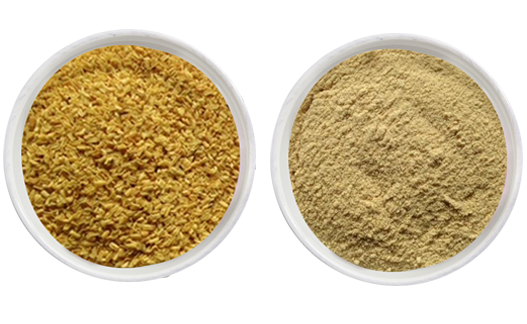Cassia Gum Powder

Cassia tora powder made from cassia tora seeds and cassia tora splits are some ancient natural ingredients. In India, cassia tora is used as a natural pesticide in organic farms. Roasted seeds are substituted for coffee, like tephrosia seeds. Cassia tora powder is most popularly used in the pet-food industry. It is mix with guar gum for use in mining and other industrial application.
Cassia gum is the purified flour from the endosperm of the seeds of Cassia tora and Cassia obtusifolia which belong to the leguminosae family. Seeds of Cassia occidentalis are a naturally occurring contaminant in the source material.The intended use of Cassia gum is as thickener, emulsifier, foam stabilizer, moisture retention agent and/or texturizing agent in cheese, frozen dairy desserts and mixes, meat products and poultry products. Cassia gum is combined with other hydrocolloids such as Carrageenan or Xanthan gum, they will synergistically form gels with unique properties.
Regulatory Information Regulatory Information Gel (synergy) with Carrageenan or Xanthan
Gum Cassia Gum is used as
- Cassia gum is approved for use in Europe by the Commission Directive (EEC No. E 499) and is listed in the Annex of the Council Directive (70/524/EEC) as a stabilizer (thickening and gelling agent) in the manufacture of canned pet foods (for cats and dogs).
- It is also approved for use in Japan and is listed as a food additive in The Ministry of Health and Welfare Announcement No. 160 (10 August 1995).
- A panel of experts in the areas of toxicology, pharmacology and food science was assembled to review the safety of cassia gum for use as a thickening agent in human and pet foods in the United States.
- The available data on cassia gum and structurally related gums demonstrate a lack of toxic effects in animals. This review is the basis for the consideration of cassia gum as generally recognized as safe (GRAS) under conditions of its intended use as a thickening agent in human and pet foods.
- Abbreviations : FFDCA, Federal Food, Drug, and Cosmetic Act; GRAS, generally recognized as safe; NTP, National Toxicology Program; OECD, Organisation for Economic Cooperation and Development; PADI, possible average daily intake
Applications
- Pet Food
- Feed Industry
- Nutraceuticals
- Cosmetics
- Personal Care
- Food
Regulatory Status
- United States TSCA
- Canada NDSL
- Korea ECL
- Australia AICS
- Europe EINECS
Cassia gum forms firm, thermoplastic gels with carrageenan. As the level of cassia gum is increased, the gel strength of carrageenan solutions is also increase. Cassia gum and carrageenan gel is stable due to the excellent retorting stability of cassia gum.
Cassia gum and xanthan gum, on their own, do not have the ability to form gels. But cassia gum combined with xanthan gum, aqueous dispersions of cassia gum form cohesive, elastic gels. As with carrageenan, cassia is more efficient at forming gels with xanthan gum than other galactomannans, enabling lower total hydrocolloid levels in finished formulations. This is due to the unique branched polysaccharide galactose/mannose structure of cassia gum.
Cassia gum is manufactured from the endosperm of Senna obtusifolia or Cassia obtusifolia or Cassia Tora or Cassia Occidentalis). It is mainly used as a thickener and gelling agent in foods and pet foods. Cassia grows mainly in subtropical regions and is grows mostly wild and occasionally cultivated.
Cassia Gum is comprised of at least 75% polysaccharide consisting primarily of a linear backbone chain of mannose with side galactose units The ratio of Mannose : Galactose is about 5: 1.
Cassia gum, like LBG can form gels with other colloids like Carrageenan and Xanthan and is therefore used in the manufacture of gels in the food and pet food applications in combination of other colloids.
| CAS No. of Cassia Gum Powder (Galactomannan) | 11078-30-1 |
| INS NO for Cassia Gum Powder | 427 |
| EINECS No. of Cassia Gum Powder | 234-299-6 |
| EEC No. of Cassia Gum Powder | E499 |
Cassia Tora Powder international listings
| Australia (AICS) | Listed |
| Korea | KE – 17406 |
Gelling properties of refined cassia gum powder :
Refined Cassia gum is a high number of galactose side chains prohibit the synergistic gelling effect with anionic polymers. As a result, a smaller amount of hydrocolloid blend containing cassia gum is needed in a food product to achieve the same effect as with carrageenan alone or blends of carrageenan with other related galactomannans.
Cassia Gum is mainly used as a:
- Gelling Agent
- Thickener
- Emulsifier
- Stabiliser
- Bonding agent
Technical Specification
Naturally sourced Cassia Tora for Food Products and Gelling.
Cassia Tora Exporter from INDIA.
Cassia Tora is generally used as an excellent and reasonable stabilizer as well as gelling agent in many aqueous systems. Technical specification of 60 mesh cassia powder and 100 mesh cassia powder are mentioned below
Product : Cassia Tora Powder – 60 Mesh
Used for Stabiliser, Binding & Gelling, Thickening.
-
Organoleptic
- - Colour : Off White To Yellowish
- - Odour : Practically Odourless.
-
Properties
- - Physical & Chemical
| Moisture | MAX. 12 % | Protein (N X 6.25) | MAX. 06 % |
| Fiber | MAX. 10 % | Gum (By Diff.) | MIN. 80 % |
| Ash | MAX. 1.0 % | Acid Insoluble | MAX. 02 % |
| Fat | MAX. 1.0 % | pH | 6.0 – 7.5 |
Microbiological Test
| Specification | 60 Mesh |
| Total Plate Count / Gms. | 3000 Max. |
| Yeast and Mold / Gms. | 100 Max. |
| Salmonella / 25 Gms. | Absent |
| E. Colli / 10 Gms | Absent |
| Colliform | Absent |
| Viscosity : | Hot Viscosity 5% sol. Brookfield. Spindle No. 7, 20 RPM @ 25°C. TEMP, 50,000 – 150,000 CPS. |
| Gel Stern : | 500 |
| Chrysophanic Acid : | Max. 0.2 PPM. |
| Particle Distribution : | 60 Mesh Pass Thru 80 – 100 % |
| Packing : | 25Kg. Net HDPE Poly Woven Paper Bags Inside Liner. |
| Product : Cassia Tora Powder – 100 Mesh | |||
| Used for Stabiliser, Binding & Gelling, Thickening. | |||
| Organoleptic : | Colour : Off White To YellowishOdour : Practically Odourless. | ||
| Properties : | Physical & Chemical | ||
| Moisture | MAX. 12 % | Protein (N X 6.25) | MAX. 06 % |
| Fiber | MAX. 10 % | Gum (By Diff.) | MIN. 80 % |
| Ash | MAX. 1.0 % | Acid Insoluble | MAX. 02 % |
| Fat | MAX. 1.0 % | pH | 6.0 – 7.5 |
Microbiological Test
| Specification | 100 Mesh |
| Total Plate Count / Gms. | 3000 Max. |
| Yeast and Mold / Gms. | 100 Max. |
| Salmonella / 25 Gms. | Absent |
| E. Colli / 10 Gms | Absent |
| Colliform | Absent |
Viscosity : Hot Viscosity 5% sol. Brookfield. Spindle No. 7, 20 RPM @ 25°C. TEMP, 50,000 – 150,000 CPS.
Gel Stern : 500
Chrysophanic Acid : Max. 0.2 PPM.
Particle Distribution : 100 Mesh Pass Thru 80 – 100 %
Packing : 25Kg. Net HDPE Poly Woven Paper Bags Inside Liner.
